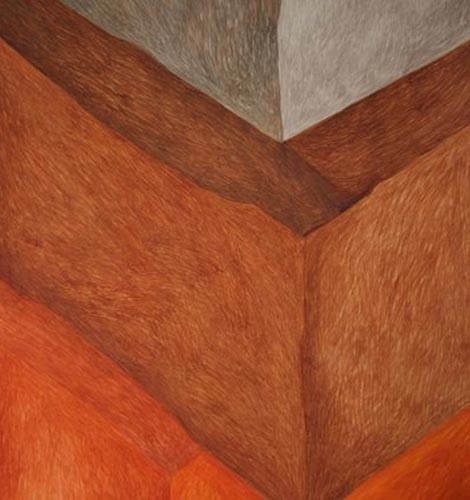Let’s start with ‘Another New Beginning’ by Pooja Iranna at Palette Art Gallery, New Delhi, where her solo show, ‘In the Waves and Underneath’, opened yesterday night (9th September 2010). ‘Another New Beginning’ is a seven minutes long video; the first video ever by our beloved artist, Pooja Iranna. It opens with a vertical architectural image slowly writhing like a reptile and moving towards the left upper corner of the screen. Then it comes down to a symmetrical form filling up the screen horizontally. The symmetry slowly gives you the impression of a large ship and your anticipation is proved right when at the far end of the screen a horizon line appears, clouds fill in the sky and in the middle-fore grounds waves start lashing. Against a dark ominous sky, the ship tosses itself up and down on angry waves and moves towards the left side of the screen and disappears.
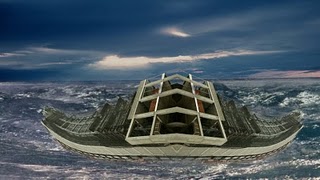
(Another New Beginning- Video Still by Pooja Iranna)
My enlightened readers have already thought of two images; of the apocalypse and Noah’s Arc. It is apocalyptic in a sense that it reveals something (apocalypse also means revelation) and it reminds you of Noah’s Arc because it is in this vessel the grand old man, Noah collected all the specimen species for future distribution. Pooja must be envisaging a time when the architectural forms erasing the presence of human beings and making them live like mice within those structures conceived and executed by them. Also, the artist must be thinking of a scenario in which on the Day of Judgment, when the deluge covers earth, architectures will turn into floating devices and take people away from divine wrath.
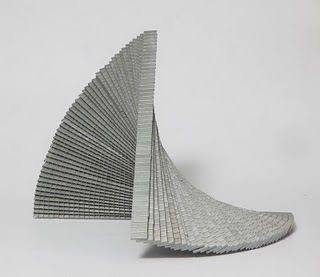
(Confluence- stapler pin sculpture by Pooja Iranna)
It could be one way of reading Pooja’s video. However, I don’t want to stop it there. I want to probe the possibility of interpreting the architecture transforming into a ship against the light of shock doctrine (studied in detail by Naomi Klein in her book titled ‘Shock Doctrine: The Disaster Capitalism). In Pooja’s video, if you look at it carefully, the architectural form does not really turn into an arc, instead it turns into a warship with all its menacing features. And also you see that this ship is not carrying anyone away from an impending calamity.
Shock doctrine is a theory developed out of the practice of the early psycho therapists, who used electric shock as a remedy to cure mental imbalance. Their idea was/is to ‘rub the slate clean’. A patient’s brain is rubbed clean through electric shocks. This crude method of indoctrinating discipline and cure was later used by punitive facilities of military regimes where they subjected the captives to shock treatment in order to ‘make them clean’. The American economist Milton Freedman found out the potential of shock doctrine in engineering social changes. For example, he proposed that a calamity whether it is natural or man made, is not a calamity but an opportunity (He observed that "only a crisis - actual or perceived - produces real change”) You give the shock to a particular society and wipe it clean and the cleaned area is not a result of devastation therefore useless, but an opportunity to start everything afresh. This theory was later used in claiming back New Orleans from poor settlers and squatters by the corporate builders who had been eyeing the property for ages. When Hurricane Katrina hit the shores of New Orleans, decades’ old desire of the corporate houses satisfied in one go. The shore was wiped clean and the squatters were uprooted and shattered. Same shock doctrine was used over Iraq during the second Gulf War. America carpet bombed Iraq to shock people out of their wits and inscribe their minds with the image of the mighty new savior; the USA.
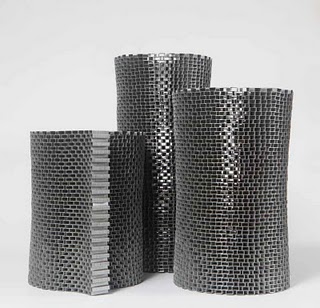
(The Twist- Stapler pin sculpture by Pooja Iranna)
In Pooja’s video, the imagined apocalypse appears as an opportunity; it suddenly rips open the glossy covers of the political system. And we come to see that behind the façade of social progress there is a militaristic system that subjects human beings into inexplicable difficulties. Here, in this new age day of apocalypse, we see the architectural forms, which herald the arrival of real global corporate culture into our lives turning into a war ship. It eventually does not take anyone to safer shores. It leaves the people behind to witness the roaring ocean turning its color into the gloom and darkness. Our minds are now wiped clean and a new indoctrination is possible now. Any calamity is an opportunity for the political-militarist powers. Pooja’s video has this sub-text. For her apocalypse is (whether actual or perceived) something that produces ‘real change’. And with her genuine subtlety, she points a finger of critique at this notion of ‘real change’.
It could be quite accidental that Pooja’s project happens at a time we all witness the effects/efforts of disaster capitalism. In the name of Commonwealth Games the powers that are have created an actual ‘disaster’ in the city of Delhi. Though the shock doctrine applied on the city of Delhi was meant for positive changes in terms of city planning and organization, it has resulted into a major disaster from which we are all sure that the political and economic powers would reap several opportunities.
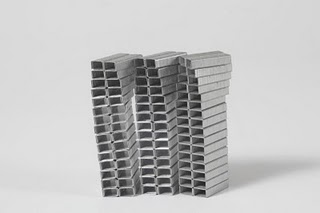
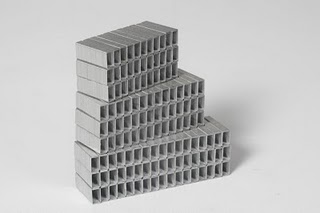


(Untitled sculptures detail from Pooja Iranna)
Pooja perceives the effects of this subtle shock doctrine applied by the global capitalism in the proliferation of urban architecture. She creates miniatures of late/post capitalist corporate architectures using stapler pin as her medium. Stapler pins, practically are devices that holds pieces of paper together. Brittle and minute in themselves these pins, metaphorically speaking, emblematize the ‘strength of the weak’. The stapler pins, painstakingly put together by the artist on the one hand shows the artistry and innovative quality of Pooja and on the other hand forwards a critique of the menacing character of the urban buildings, which lean, twirl and twist like creatures from a nether land. These imagine architectures show how urban spaces are created not by keeping living organisms including human beings, flora and fauna as the centre of its discourse but as keeping presence of power as its point of departure. Architectures in Pooja’s sculptural installations with stapler pins are not only the symbolic of the might power but also their underlying message of threat.
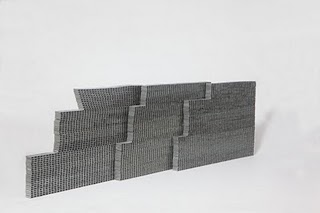
(Everything is not Straight - sculpture by Pooja Iranna)
What happens when the topography of a place is chartered and marked by well defined and designed architectures and streets? True, that it makes life easier. But If we look at it from a different perspective, which is more human, we come to know that such planning make governing easier. Planning in fact controls the human movement, it curtails the human beings’ innate desire to revolt and go under ground. It also reveals every nook and corner of a place/space while pretending that it exactly hides such places. A planned city is a place where the possibilities of revolt are minimized. Usually, we say that in the chaotic third world urban places, guerilla activities flourish thanks to its ability to absorb people into it innards. But with the establishment of corporate cities, the ruling powers flush out such unmarked spaces by incorporating them into the planned topography. By creating idols of such defined architectures, Pooja makes an ironic statement on progress and through that she forwards a critique of shock doctrine through urban planning.
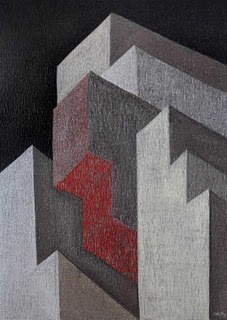
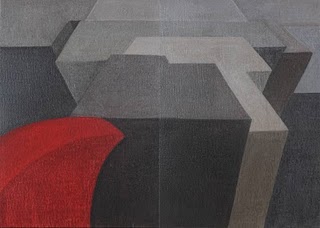
(Standing at the Edge I and II, Painting by Pooja Iranna)
Pooja’s drawings and paintings are minimal and they bear concrete and abstract qualities of two dimensional art at the same time. The scratching and doodling of her early works on parchment and canvas have given way to more painterly strokes and carefully added blobs of wax as if they were beads attached to a traditional wear. Metaphorically and symbolically, at least for me as an art critic, they are the corners and abandoned spaces traced out from our urban locations. These corners and abandoned spaces, while being integral to the main architectures, do not find articulation in the discourse of planning. That’s why they become the places to spit, urinate or hide. These unarticulated liminal spaces find a voice in Pooja’s paintings and drawings. And from different distances you find different visual qualities to these images. From the middle distance of viewing, you find that they are pillars, joint of walls, corners, armatures, scaffoldings, blueprints and so on, which normally are not taken care of in the final counting of the urban spaces.
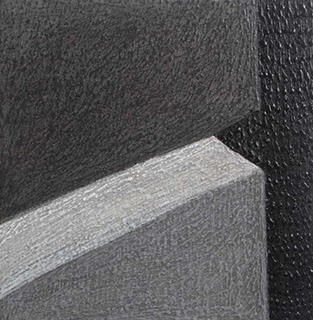
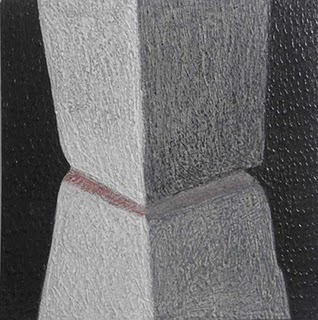
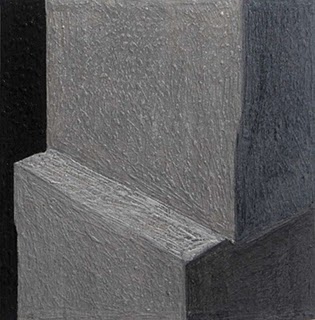
(Drawings by Pooja Iranna)
As an end note, a couple of things I would like to point out. Once again as an accident, you find this show of Pooja opens on another 9/11. Nine years back, on this day, we all were shocked by a terrorist adventure in the US. That was the shock doctrine of a different kind. The militants were using the same logic of shock therapy to the political mind of the first world (read the USA). Today, we have Pooja’s architectural forms remotely reminding the collapsed twin towers. There is an uncanny feeling you get while stand before the works (Once again quite by chance, a stapler pin sculpture fell down and broke into pieces. Was there an Al-quida wave in the air? J)
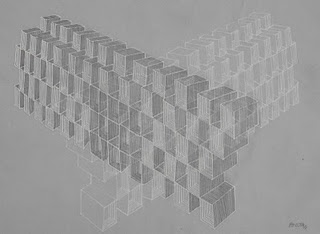
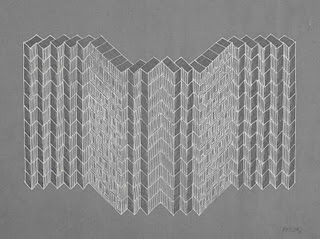
(Drawing by Pooja Iranna)
Finally, oh my God, I have got an opportunity to see a woman artist’s work without vaginas, menstrual blood and pubic hair. There is no hint of it in Pooja Iranna’s work. Feminine approach in art could be many times bolder than the male approach. With no phallic symbols, with no toothed vaginas and no trace of sanitary napkins, Pooja proves that it is possible. And I am happy for that and all of you know that between this critic and this artist there is a secret bonding. To know that check my profile in facebook and check her date of birth in Palette Art Gallery website.
JohnyML
http://johnyml.blogspot.com/2010/09/without-vaginas-menstrual-blood-and.html



